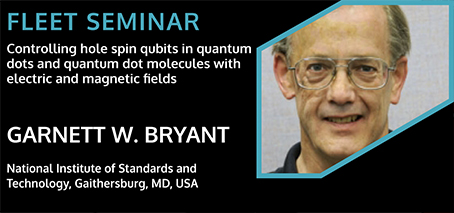-
16 Nov 2018
11:30 am - 12:30 pm
Controlling hole spin qubits in quantum dots and quantum dot molecues with electric and magnetic fields
Prof. Garnett W. Bryant. National Institute of Standards and Technology, Gaithersburg, MD, USA
All welcome! The seminar flyer can be downloaded clicking on this link
Abstract:
Hole spins in quantum dots (QDs) are promising qubits for quantum technologies. All-optical control is possible using QD molecules (QDMs). Hole spin-mixing in InAs QDMs enables this all-optical control. Understanding this spin-mixing has stimulated a rethinking of hole spin in QDs. We use atomistic tight-binding theory for GaAs QDs, InAs QDs and InAs/GaAs QDMs to study the effect of QD geometry and magnetic field B on hole spin-polarization, spin-mixing and spatial texturing of the spin inside the QD. Due to strong spin-orbit coupling, the hole spin is strongly polarized and locked to the QD axis rather than to B except for in-plane B where the net hole spin is depolarized due to the internal spatial texture of the spin. Application of a lateral electric field parallel to an in-plane B provides exquisite control of the hole spin and Zeeman splitting. Strong spin polarization is recovered when the electric field pushes the hole to one side of the QD. This control is disrupted if the QD is an alloy because alloy disorder scrambles the spin texture at the atomic scale. However, applying a lateral electric field with an in-plane B can restore the spin even with alloy disorder. Strong spin-orbit coupling combined with strong locking of the orbital motion to the QD geometry explains spin locking away from Voigt configuration, spin depolarization in Voigt configuration, the spin texture patterns, repolarization of the spin with applied lateral electric field, response to applied strain and spin scrambling in alloys.
This spin control can be related to the QD geometry. The question remains whether this can be explained as a Rashba effect originating from interface fields or is inherent to an atomistic description of hole spins in QDs. GaAs/AlAs QDs with a graded alloy describing the QD interface to minimize Rashba effects of sharp interfaces are studied. The results are compared with results for QDs with sharp interfaces. Several examples illustrate how a graded interface influences the spin locking seen for QDs with sharp interfaces and how this changes spin texture and spin polarization in the Voigt configuration. The results are used to assess the contribution of Rashba effects.
Recent experiments on InAs QDs integrated with GaAs mechanical resonators show significant strain-induced coupling between the QD and mechanical motion. Photoluminescence of single QDs for in-plane B, measured synchronously with the driven mechanical resonator, shows large, strain-induced changes in hole Zeeman splitting with small changes in electron Zeeman splitting. Proper treatment of spin locking and alloy scrambling provides an explanation for the large strain-induced shifts of hole Zeeman splitting.
Venue: G59-G60, Old Main Building K15
Address:

